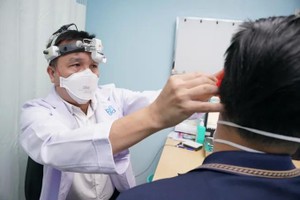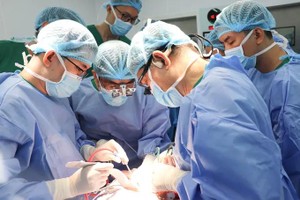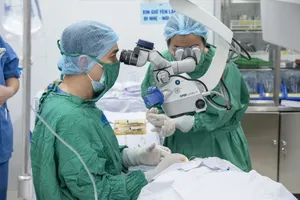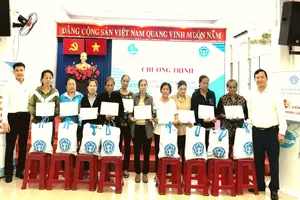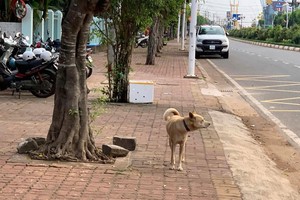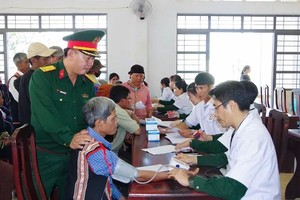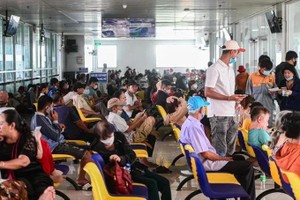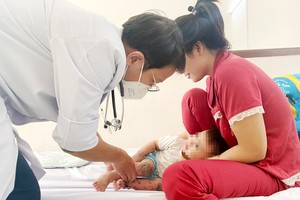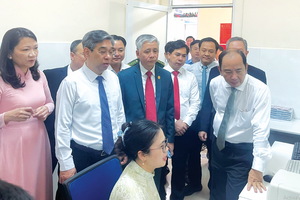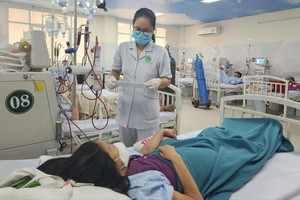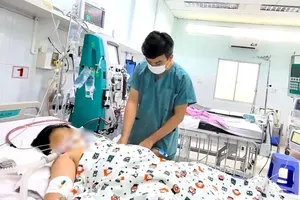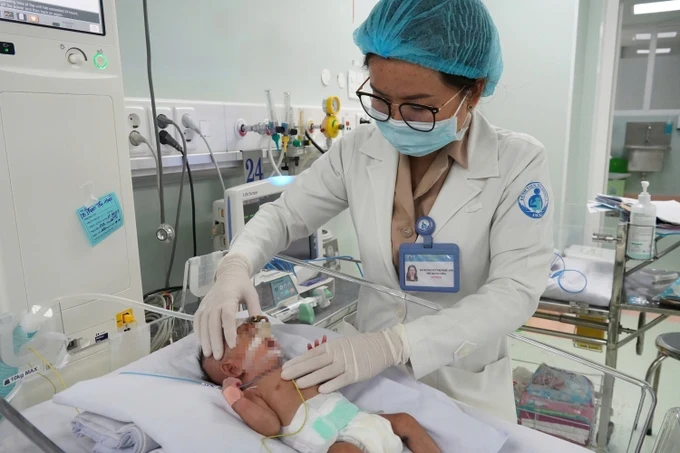
Undertaking a hurried journey from Dak Lak Province with her newborn daughter, just three weeks old, to Children’s Hospital No.1 in HCMC, Le Thi Ha Quyen carried a fragile hope that her child would be spared from blindness caused by Retinopathy of Prematurity (ROP).
Ha Quyen’s daughter was born prematurely at just 26 weeks gestation, weighing a mere 900 grams. During a routine screening, doctors at Dak Lak Province General Hospital identified a risk of blindness due to the preterm birth and promptly advised Quyen to seek treatment at Children’s Hospital No.1.
“I earnestly hope the baby can be treated early and achieve stable vision”, Quyen shared, her eyes red-rimmed with emotion as she accompanied nurses wheeling her daughter towards the operating room. “If screening and treatment aren’t performed, I dread to think what the child’s future might hold.”
Quyen’s situation is shared by dozens of parents whose children are currently undergoing medical intervention at the Center for Screening and Treatment of Retinopathy of Prematurity (ROP) at Children’s Hospital No.1 – notably, the first such specialized center in Vietnam.
According to Level-II Specialist Nguyen Thi Ngoc Anh, Acting Head of the Ophthalmology Department at the hospital, ROP stands as one of the primary drivers of visual impairment in premature infants globally, a concern particularly acute in developing nations.
Statistics from the World Health Organization (WHO) highlight the scale of the challenge. An estimated 15-20 million low birth weight infants are born annually worldwide, with 10-20 percent facing a high risk of ROP if timely screening and intervention are not provided.
“In Vietnam, the rate of premature and low birth weight infants is unfortunately increasing, bringing a higher risk of ROP”, Acting Head Nguyen Thi Ngoc Anh explained. “Previously, this condition was largely unfamiliar in our country, and many patients were blind without understanding the cause, simply attributing it to congenital blindness. As healthcare has advanced, surveys to identify causes revealed ROP. Before this awareness, while more premature infants were saved, the number of those affected by blindness was also high.”
The journey of the Center for Screening and Treatment of ROP began in 2004 when Children’s Hospital No.1 benefited from support from ORBIS, a non-governmental health organization. ORBIS facilitated expert training and equipped the center with necessary machinery and equipment for examining and treating such babies.
In its nascent stages, treatment was limited to laser photocoagulation. However, by 2015, the center had incorporated an innovative therapeutic approach utilizing anti-VEGF drugs. Following a period of operation and development, Children’s Hospital No.1 formally inaugurated ROP Center in 2017.
Overseeing the center, Acting Head Ngoc Anh recalled that initial operations faced considerable challenges. However, timely screening immediately after birth is paramount for diagnosing and treating infants during the crucial “golden time”.
Fortunately, robust collaboration with obstetrics and gynecology hospitals in HCMC, support from HCMC Eye Hospital, and seamless linkage with other departments within Children’s Hospital No.1 for parent counseling have ensured that all cases accepted for treatment achieve favorable outcomes. To date, the ROP treatment success rate at the center consistently exceeds 98 percent.
For Nguyen Thi Thuy Duong from Go Vap District of HCMC, whose child received treatment for ROP, the center felt like a lifeline for her family. “The day the doctor told my baby Minh Phat faced the prospect of losing his sight due to premature birth, I was overcome with tears”, Thuy Duong confided. “Fortunately, the doctor provided thorough counseling and explanation regarding the treatment method, allowing my family to find reassurance and place trust in the prescribed protocol. After a single injection, the baby’s vision became stable, just like other children – it was nothing short of miraculous!” She continues to attend regular follow-up appointments for her child as scheduled by the doctor.
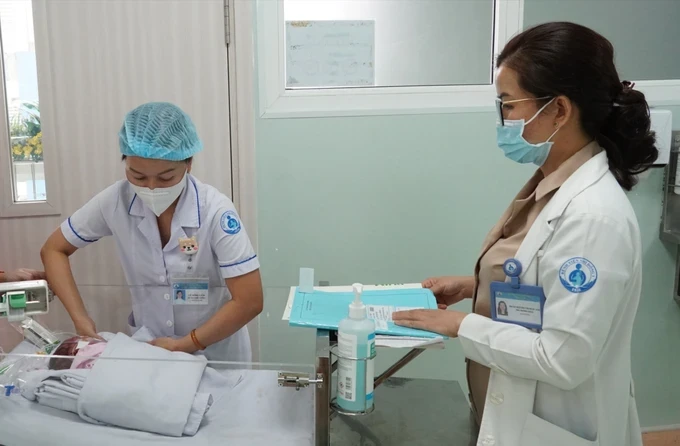
The cost associated with a ROP screening and treatment case is approximately VND5 million (US$193) per intravitreal injection or VND4 million ($154) per laser surgery session. Level-II Specialist Ngoc Anh pointed out that if treated within the “golden time”, most babies respond favorably to just a single intravitreal injection. In cases of delayed intervention, however, the cost of treatment could escalate significantly, potentially reaching up to VND100 million ($3,800) per eye.
The ROP treatment model developed at the center has successfully extended its reach significantly to numerous other provinces and cities.
Children’s Hospital No.1 has actively disseminated and transferred its screening expertise to hospitals in provinces and cities including Da Nang, Quang Nam, Binh Dinh, Dong Nai, Gia Lai, Dak Lak, Can Tho, and Ca Mau. As a result, Can Tho City Children’s Hospital, for instance, is now capable of providing treatment for young patients.
Furthermore, at major obstetrics and gynecology hospitals in HCMC, such as Hung Vuong Obstetrics and Gynecology Hospital and Tu Du Hospital, Children’s Hospital No.1 doctors are present weekly to provide specialized professional support for ROP treatment.
Given the expanding geographical reach of the screening expertise transferred by Children’s Hospital No.1 doctors, Acting Head Ngoc Anh strongly urges parents of premature infants to seek early screening to safeguard their child’s future.
Recognizing the significant accomplishments over the past period, the model of the Center for Screening and Treatment of ROP in premature infants at Children’s Hospital No.1 garnered high praise from the City-level Council reviewing nominations for the 4th HCMC Innovation Award 2025 and was recommended for an award.
Key ROP statistics from 2017-2024:
- The number of screenings performed for ROP saw a sharp increase, from 9,732 in 2017 to over 18,000 in 2024.
- On average, roughly 400 children require treatment each year.
- Between 2017 and 2024, the ROP Center provided treatment for approximately 2,120 child patients.
- The center’s work is also contributing to a reduction in social welfare expenditure for children with disabilities by nearly VND300 billion ($11.6 million).

